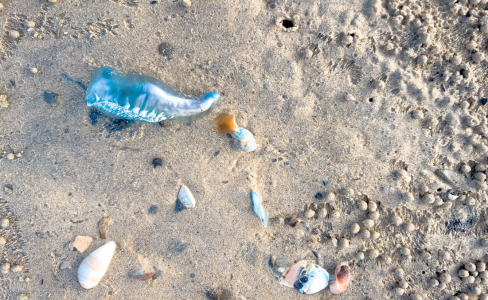Shocking Invasion at Bronte Beach: Find Out Why Thousands of Bluebottle Jellyfish Are Taking Over!
By
Gian T
- Replies 1
Bronte Beach, a jewel among Sydney's coastal attractions, has recently experienced an unusual and somewhat alarming event. Just days after nearby beaches were closed due to the mysterious appearance of black tar balls, Bronte was the site of a massive wash-up of bluebottle jellyfish, known for their painful stings.
The scene at Bronte Beach was awe and concern as hundreds of these sapphire-tinted creatures, also known as Portuguese men of war, were strewn across the sand. The beach, nestled between the iconic Bondi Beach and the family-friendly Coogee Beach, became a no-go zone for swimmers due to the risk posed by these venomous visitors.
Bluebottles are common on Australia's east coast, especially during the warmer months. However, the sheer number of jellyfish that invaded Bronte Beach was notable. While these creatures are not lethal to humans, their sting can cause significant discomfort and, in some cases, severe allergic reactions.
In response, Waverley Council issued a statement explaining that the bluebottles were brought ashore by prevailing onshore winds and were most noticeable at high tide, particularly at the southern end of Bronte Beach, which is exposed to north-easterly winds. The council assured the public that regular beach cleaning was scheduled to address the issue, with additional inspections and clean-ups planned if necessary.
But what exactly are blue bottles, and why do they end up on our beaches in such numbers? According to researchers Amandine Schaeffer and Jasmin C Lawes from UNSW, bluebottles are not single organisms but rather floating colonies made up of individual zooids, each with its own specialised function, such as reproduction, feeding, or sailing. Their long, trailing tentacles are equipped with venom-filled nematocysts used to incapacitate prey and defend against threats.
The timing of this bluebottle 'invasion' was particularly interesting, coming shortly after Coogee Beach was closed due to an influx of tar balls, which were identified as hydrocarbon-based pollutants. While the two incidents are not directly related, they both highlight the vulnerability of our beaches to various forms of marine pollution and natural phenomena.
The recent events at Bronte and Coogee Beaches serve as a reminder of the delicate balance that exists between human activities and the natural environment. While the source of the tar balls at Coogee was suspected to be a ship or runoff, marine biologist Lawrence Chlebeck emphasised the need for more evidence to determine the cause of such pollution.
As beachgoers, it's crucial to stay informed about the conditions of our local beaches, not only for our safety but also to understand the impact we have on these ecosystems. The bluebottle swarm at Bronte Beach may be a natural occurrence, but it underscores the importance of respecting and protecting our coastal environments.
We recommend always checking the latest beach conditions for our members who enjoy the sun and surf before heading out. And suppose you do encounter bluebottles or any other marine life washed up on the shore. In that case, it's best to admire them from a distance and report any significant findings to the local council or relevant authorities.
 Have you experienced a bluebottle sting or a similar event on your local beach? Please share your stories with us in the comments below, and let's discuss how we can all contribute to keeping our beaches safe and clean for everyone to enjoy.
Have you experienced a bluebottle sting or a similar event on your local beach? Please share your stories with us in the comments below, and let's discuss how we can all contribute to keeping our beaches safe and clean for everyone to enjoy.
The scene at Bronte Beach was awe and concern as hundreds of these sapphire-tinted creatures, also known as Portuguese men of war, were strewn across the sand. The beach, nestled between the iconic Bondi Beach and the family-friendly Coogee Beach, became a no-go zone for swimmers due to the risk posed by these venomous visitors.
Bluebottles are common on Australia's east coast, especially during the warmer months. However, the sheer number of jellyfish that invaded Bronte Beach was notable. While these creatures are not lethal to humans, their sting can cause significant discomfort and, in some cases, severe allergic reactions.
In response, Waverley Council issued a statement explaining that the bluebottles were brought ashore by prevailing onshore winds and were most noticeable at high tide, particularly at the southern end of Bronte Beach, which is exposed to north-easterly winds. The council assured the public that regular beach cleaning was scheduled to address the issue, with additional inspections and clean-ups planned if necessary.
But what exactly are blue bottles, and why do they end up on our beaches in such numbers? According to researchers Amandine Schaeffer and Jasmin C Lawes from UNSW, bluebottles are not single organisms but rather floating colonies made up of individual zooids, each with its own specialised function, such as reproduction, feeding, or sailing. Their long, trailing tentacles are equipped with venom-filled nematocysts used to incapacitate prey and defend against threats.
The timing of this bluebottle 'invasion' was particularly interesting, coming shortly after Coogee Beach was closed due to an influx of tar balls, which were identified as hydrocarbon-based pollutants. While the two incidents are not directly related, they both highlight the vulnerability of our beaches to various forms of marine pollution and natural phenomena.
The recent events at Bronte and Coogee Beaches serve as a reminder of the delicate balance that exists between human activities and the natural environment. While the source of the tar balls at Coogee was suspected to be a ship or runoff, marine biologist Lawrence Chlebeck emphasised the need for more evidence to determine the cause of such pollution.
As beachgoers, it's crucial to stay informed about the conditions of our local beaches, not only for our safety but also to understand the impact we have on these ecosystems. The bluebottle swarm at Bronte Beach may be a natural occurrence, but it underscores the importance of respecting and protecting our coastal environments.
We recommend always checking the latest beach conditions for our members who enjoy the sun and surf before heading out. And suppose you do encounter bluebottles or any other marine life washed up on the shore. In that case, it's best to admire them from a distance and report any significant findings to the local council or relevant authorities.
Key Takeaways
- Bluebottle jellyfish have washed up in large numbers on Sydney's Bronte Beach, posing a risk to swimmers.
- Waverley Council has promised to clean up the beach and will keep an eye on the situation, cleaning as necessary.
- Researchers explain that bluebottles are colonies of various organisms that work together and have painful stings.
- The incident follows the recent closure of Coogee Beach due to mysterious tar balls washing ashore.








